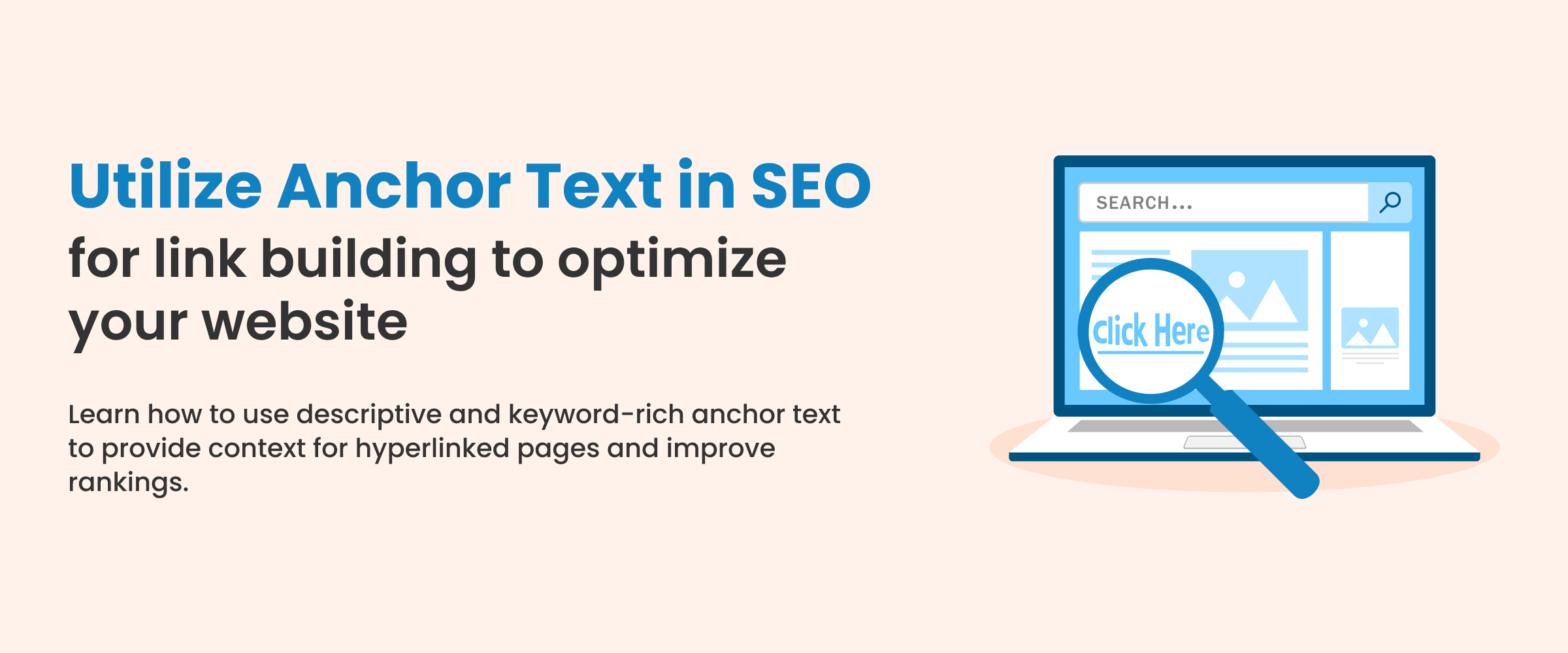Anchor Text in SEO – The Power of Hyperlinked Words
In SEO, anchor text shapes a website’s visibility and authority. Whether you are an experienced SEO professional or a website owner trying to understand the intricacies of digital marketing, grasping the concept and significance of anchor text SEO is essential. In this blog, we will look into the depths of anchor text SEO, its importance, different types, best practices, its evolving role in the digital landscape, and more.
What is Anchor Text?
In simple terms, anchor text refers to the visible, clickable text within a hyperlink. When you link one web page to another, the clickable part of the link, usually highlighted in blue and underlined, is known as the anchor text. For example, consider the following sentence: “To learn more about on-page SEO, click here.” In this case, “click here” is the anchor text, which will direct users to the relevant page discussing on-page SEO when clicked.
Its primary purpose is to provide context and relevance to the linked page, guiding both search engine bots and users about the content they can expect on the target page. Learn more about anchor text in an online digital marketing course.
The Importance of Anchor Text in SEO
A well-optimized anchor text SEO strategy is essential for enhancing both search engine rankings and the user experience. Let’s look at some ways to drive organic traffic to websites.
- Relevance and Context: When search engines crawl the web, they use anchor text to understand the topic and context of the linked page. Well-optimized anchor text provides valuable signals about the content of the linked page, helping search engines rank it for relevant queries.
- Link Building: Anchor text SEO is a crucial element in link-building strategies. When other websites link to your pages using specific anchor text, it can positively impact your website’s search rankings for keywords related to that anchor text.
- User Experience: Thoughtful anchor text helps users comprehend the linked content without the need to click, thereby improving the overall user experience and reducing bounce rates.
- Accessibility: Properly crafted anchor text SEO can also benefit users with disabilities who use screen readers to navigate the web. Descriptive anchor text provides a better understanding of the link’s destination, ensuring a more inclusive online experience.
Get hands-on project experience by enrolling in the best digital marketing course with placement.
Types of Anchor Text
Various types of anchor text SEO exist, each serving different purposes and influencing SEO differently. Understanding these types is important for creating a diverse and natural backlink profile.
1. Exact Match Anchor Text
This type of anchor text includes the exact target keyword or phrase of the linked page. While it was once heavily used for SEO purposes, overusing exact match anchor text today can lead to penalties as it appears manipulative.
2. Partial Match Anchor Text
Partial match anchor text includes variations of the target keyword or phrase, incorporating additional words to create a more natural-sounding link. It strikes a balance between keyword optimization and user-friendliness.
3. Branded Anchor Text
Branded anchor text includes the name of the brand or company being linked to. It helps reinforce brand visibility and recognition while also building brand authority.
4. Naked URLs
This type of anchor text consists of the raw URL itself (e.g., http -//www.example.com). Although not keyword-optimized, it can be valuable in certain contexts, such as for direct citations or sharing important resources.
5. Generic Anchor Text
Generic anchor text uses non-descriptive terms like “click here,” “learn more,” or “visit this site.” While it lacks SEO value, it can still be useful for user experience and accessibility.
6. LSI Keywords
Latent Semantic Indexing (LSI) keywords are contextually related terms to the target keyword. LSI keywords in anchor text help search engines grasp the broader context of the linked page.
Best Practices for Using Anchor Text
Now that we understand the significance of anchor text SEO, let’s explore some best practices to ensure it remains effective and complies with current SEO guidelines –
- Natural Language: Write anchor text that blends seamlessly with the surrounding content. Prioritize readability and relevance to the user over keyword stuffing.
- Relevance to Linked Page: Always ensure the anchor text accurately reflects the content on the linked page. Misleading anchor text can lead to a negative user experience and harm your website’s credibility.
- Diversity: Avoid using the same anchor text repeatedly, especially exact match anchors. Aim for a diverse range of anchor types to create a natural backlink profile.
- Linking to High-Quality Pages: Linking to reputable and authoritative websites enhances your website’s credibility in the eyes of both search engines and users.
- Strategic Internal Linking: Use anchor text to interlink your web pages within your website. This can help spread link equity and guide users to relevant content.
- Avoiding Over-Optimization: Refrain from over-optimizing anchor text by stuffing it with keywords. Instead, focus on providing value to users and creating a positive user experience.


The Evolution of Anchor Text in SEO
Over the years, search engines have continuously refined their algorithms to provide more accurate and relevant search results to users. As a result, the role of anchor text in SEO has evolved.
- In the past, search engines heavily relied on exact match anchor text to determine the relevance of linked pages.
- The prevalence of manipulative SEO practices, such as keyword stuffing in the anchor text, prompted search engines to shift their approach.
- Modern search engines now prioritize context and user intent over exact keyword matches.
- At present, they analyze the content of both the linked page and the source page to ensure that the anchor text fits organically within the context of the content.
- Search engines have become more proficient in understanding natural language, entity recognition, and topic modeling.
- This has led to a greater emphasis on the overall thematic relevance of a page, rather than solely relying on exact match keywords.
Difference Between Natural Anchor Text and Unnatural Anchor Text
Anchor text is a crucial aspect of SEO, but its effectiveness depends on whether it is used naturally or artificially. Let’s explore the differences between natural and unnatural text in the following comparison table.
| Aspect | Natural Anchor Text | Unnatural Anchor Text |
| Definition | Anchor text that is contextually relevant to the link’s destination. It accurately describes the linked content. | Anchor text that is irrelevant to the linked content or doesn’t make sense in the context. |
| Purpose | It helps users and search engines understand the linked content’s topic or destination. | Often used for manipulative SEO practices to try to boost rankings artificially. |
| Example | “Learn more about the benefits of organic gardening.” | “Click here,” “Check this out,” “Best SEO services.” |
| Search Engines Impact | Positive effect on search rankings when used appropriately and in moderation. | Can lead to penalties or lower rankings when overused or used inappropriately (e.g., keyword stuffing). |
| User Experience | Enhances user experience by providing clear and relevant information about the link. | Can confuse users and lead to a higher bounce rate if the anchor text doesn’t match their expectations. |
| Link Diversity | Natural variations in anchor text (e.g., different phrases, and synonyms) are common and encouraged. | Overuse of exact match anchor text can appear spammy and raise red flags for search engines. |
Conclusion
Anchor text SEO remains an essential aspect, guiding users and search engine bots to relevant content while influencing website rankings. By employing best practices, website owners and SEO professionals can leverage the power of anchor text to improve user experience, build authority, and enhance their website’s search visibility. Embracing the evolving nature of anchor text and adapting to search engine algorithm updates will ensure that your SEO efforts stand the test of time and remain effective in driving organic traffic to your website.
FAQs
Anchor text is the clickable text that links to another page, providing context. Keywords are specific words or phrases used to optimize content for search engines.
Anchor text in an image is the alternative text (alt text) that provides a description of the image’s content for accessibility and SEO purposes.
Alt text is used in image tags to describe the image’s content for visually impaired users. Anchor text is the clickable text used in hyperlinks.







